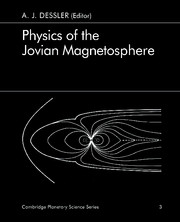Book contents
- Frontmatter
- Contents
- List of tables
- List of contributors
- Foreword
- Preface
- 1 Jupiter's magnetic field and magnetosphere
- 2 Ionosphere
- 3 The low-energy plasma in the Jovian magnetosphere
- 4 Low-energy particle population
- 5 High-energy particles
- 6 Spectrophotometric studies of the Io torus
- 7 Phenomenology of magnetospheric radio emissions
- 8 Plasma waves in the Jovian magnetosphere
- 9 Theories of radio emissions and plasma waves
- 10 Magnetospheric models
- 11 Plasma distribution and flow
- 12 Microscopic plasma processes in the Jovian magnetosphere
- Appendix A Symbols and acronyms
- Appendix B Coordinate systems
- Appendix C Jupiter and Io: selected physical parameters
- References
- Index
2 - Ionosphere
Published online by Cambridge University Press: 27 October 2009
- Frontmatter
- Contents
- List of tables
- List of contributors
- Foreword
- Preface
- 1 Jupiter's magnetic field and magnetosphere
- 2 Ionosphere
- 3 The low-energy plasma in the Jovian magnetosphere
- 4 Low-energy particle population
- 5 High-energy particles
- 6 Spectrophotometric studies of the Io torus
- 7 Phenomenology of magnetospheric radio emissions
- 8 Plasma waves in the Jovian magnetosphere
- 9 Theories of radio emissions and plasma waves
- 10 Magnetospheric models
- 11 Plasma distribution and flow
- 12 Microscopic plasma processes in the Jovian magnetosphere
- Appendix A Symbols and acronyms
- Appendix B Coordinate systems
- Appendix C Jupiter and Io: selected physical parameters
- References
- Index
Summary
Our understanding of Jupiter's ionosphere has been enhanced by the Voyager encounters. Vibrationally excited H2 (υ ≥ 4) probably played an important role in providing a rapid loss mechanism for protons (the major topside ion) during the Voyager encounter. A straightforward calculation of the Voyager 1 entry electron concentration profile with chemistry and physics adequate to understand the Pioneer radio occultation profiles yields significant differences from the Voyager radio science measurements and suggests that substantial improvements in models may be necessary if the preliminary results of the observations remain unaltered after improved reduction and analysis of the data. It is argued that, although solar EUV radiation probably controlled the ionosphere during the Pioneer observations, particle precipitation as evidenced by strong H2 airglow emissions on a planetwide basis appears to have played an essential role in both heating the thermosphere and as an ionization source during the Voyager encounters. The main contribution to the Pedersen conductivity in Jupiter's ionosphere occurs in the region where multilayer structure is dominant and accurate reductions of the Voyager radio occultation measurements are not yet available. Theoretical estimates of the integrated Pedersen conductivity are in the range of 0.02–10 mho; the former values are representative of an ionosphere produced by solar EUV radiation and the latter of the auroral ionosphere under intense particle precipitation.
Introduction
The original interest in an ionosphere on Jupiter was generated by the discovery of strong radio-frequency emissions at ~ 20 MHz that were thought to be plasma frequencies associated with Jupiter's ionosphere [Gardner and Shain, 1958].
- Type
- Chapter
- Information
- Physics of the Jovian Magnetosphere , pp. 51 - 67Publisher: Cambridge University PressPrint publication year: 1983
- 59
- Cited by



